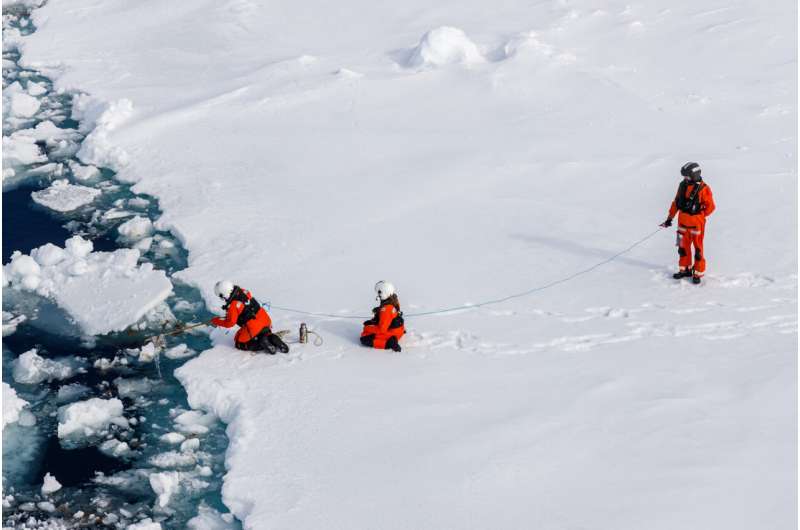The alga Melosira arctica, which grows under Arctic sea ice, contains ten times as many microplastic particles as the surrounding seawater. This concentration at the base of the food web poses a threat to creatures that feed on the algae at the sea surface. Clumps of dead algae also transport the plastic with its pollutants particularly quickly into the deep sea—and can thus explain the high microplastic concentrations in the sediment there. Researchers led by the Alfred Wegener Institute have now reported this in the journal Environmental Science and Technology.
It is a food lift for bottom-dwelling animals in the deep sea: The alga Melosira arctica grows at a rapid pace under the sea ice during spring and summer months, and forms meter-long cell chains there. When the cells die and the ice to whose underside they adhere melts, they stick together to form clumps that can sink several thousand meters to the bottom of the deep sea within a single day. There they form an important food source for bottom-dwelling animals and bacteria.
In addition to food, however, these aggregates also transport a dubious cargo into the Arctic deep sea: microplastics. A research team led by biologist Dr. Melanie Bergmann from the Alfred Wegener Institute, Helmholtz Centre for Polar and Marine Research (AWI) has now published their findings.
"We have finally found a plausible explanation for why we always measure the largest amounts of microplastics in the area of the ice edge, even in deep-sea sediment," Melanie Bergmann reports.
Until now, the researchers only knew from earlier measurements that microplastics concentrate in the ice during sea ice formation and are released into the surrounding water when it melts. "The speed at which the alga descends means that it falls almost in a straight line below the edge of the ice. Marine snow, on the other hand, is slower and gets pushed sideways by currents so sinks further away. With the Melosira taking microplastics directly to the bottom, it helps explain why we measure higher microplastic numbers under the ice edge," explains the AWI biologist.
On an expedition with the research vessel Polarstern in summer 2021, she and a research team collected samples of Melosira algae and the surrounding water from ice floes. The partners from Ocean Frontier Institute (OFI), Dalhousie University and the University of Canterbury then analyzed these in the laboratory for microplastic content. The surprising result: the clumps of algae contained an average of 31,000 ± 19,000 microplastic particles per cubic meter, about ten times the concentration of the surrounding water.
"The filamentous algae have a slimy, sticky texture, so it potentially collects microplastic from the atmospheric deposition on the sea, the sea water itself, from the surrounding ice and any other source that it passes. Once entrapped in the algal slime they travel as if in an elevator to the seafloor, or are eaten by marine animals," explains Deonie Allen of the University of Canterbury and Birmingham University, who is part of the research team.
Since the ice algae are an important food source for many deep-sea dwellers, the microplastic could thus enter the food web there. But it is also an important food source at the sea surface and could explain why microplastics were particularly widespread among ice-associated zooplankton organisms, as an earlier study with AWI participation shows. In this way, it can also enter the food chain here when the zooplankton is eaten by fish such as polar cod and these are eaten by seabirds and seals and these in turn by polar bears.
The detailed analysis of plastic composition showed that a variety of different plastics are found in the Arctic, including polyethylene, polyester, polypropylene, nylon, acrylic and many more. In addition to various chemicals and dyes, this creates a mix of substances whose impact on the environment and living creatures is difficult to assess.
"People in the Arctic are particularly dependent on the marine food web for their protein supply, for example through hunting or fishing. This means that they are also exposed to the microplastics and chemicals contained in it. Microplastics have already been detected in human intestines, blood, veins, lungs, placenta and breast milk and can cause inflammatory reactions, but the overall consequences have hardly been researched so far," reports Melanie Bergmann.
"Micro and nano plastics have basically been detected in every place scientists have looked in the human body and within a plethora of other species. It is known to change behaviors, growth, fecundity and mortality rates in organisms and many plastic chemicals are known toxins to humans," says Steve Allen, OFI Dalhousie University, a research team member.
Moreover, the Arctic ecosystem is already threatened by the profound environmental upheavals caused by the climate crisis. If the organisms are now additionally exposed to microplastics and the chemicals they contain, it can weaken them further.
"So, we have a combination of planetary crises that we urgently need to address effectively. Scientific calculations have shown that the most effective way to reduce plastic pollution is to reduce the production of new plastic," says Melanie Bergmann, and adds, "This should therefore definitely be prioritized in the global plastics agreement that is currently being negotiated." That is why Bergmann is also accompanying the next round of negotiations, which will begin in Paris at the end of May.



Recommended Comments
There are no comments to display.
Join the conversation
You can post now and register later. If you have an account, sign in now to post with your account.
Note: Your post will require moderator approval before it will be visible.